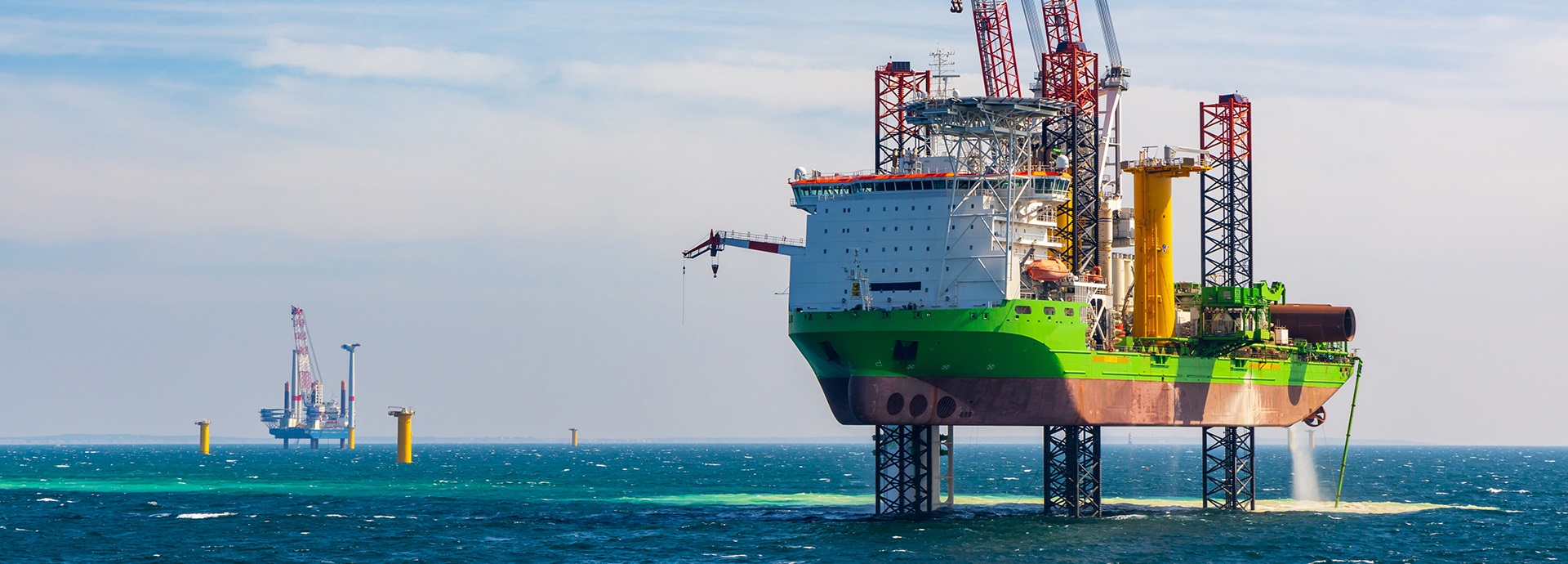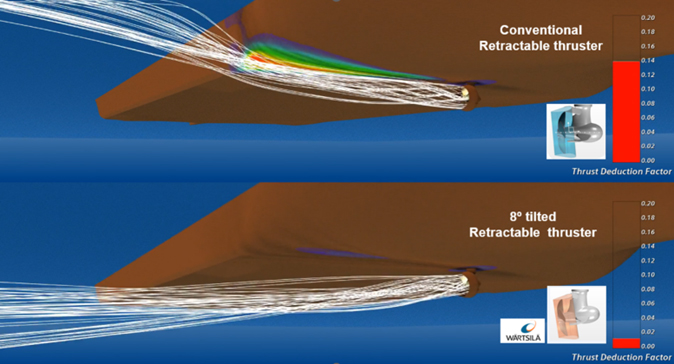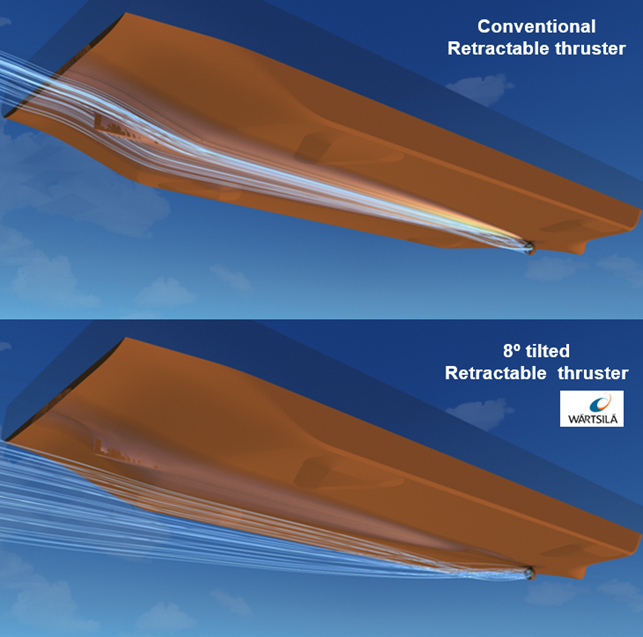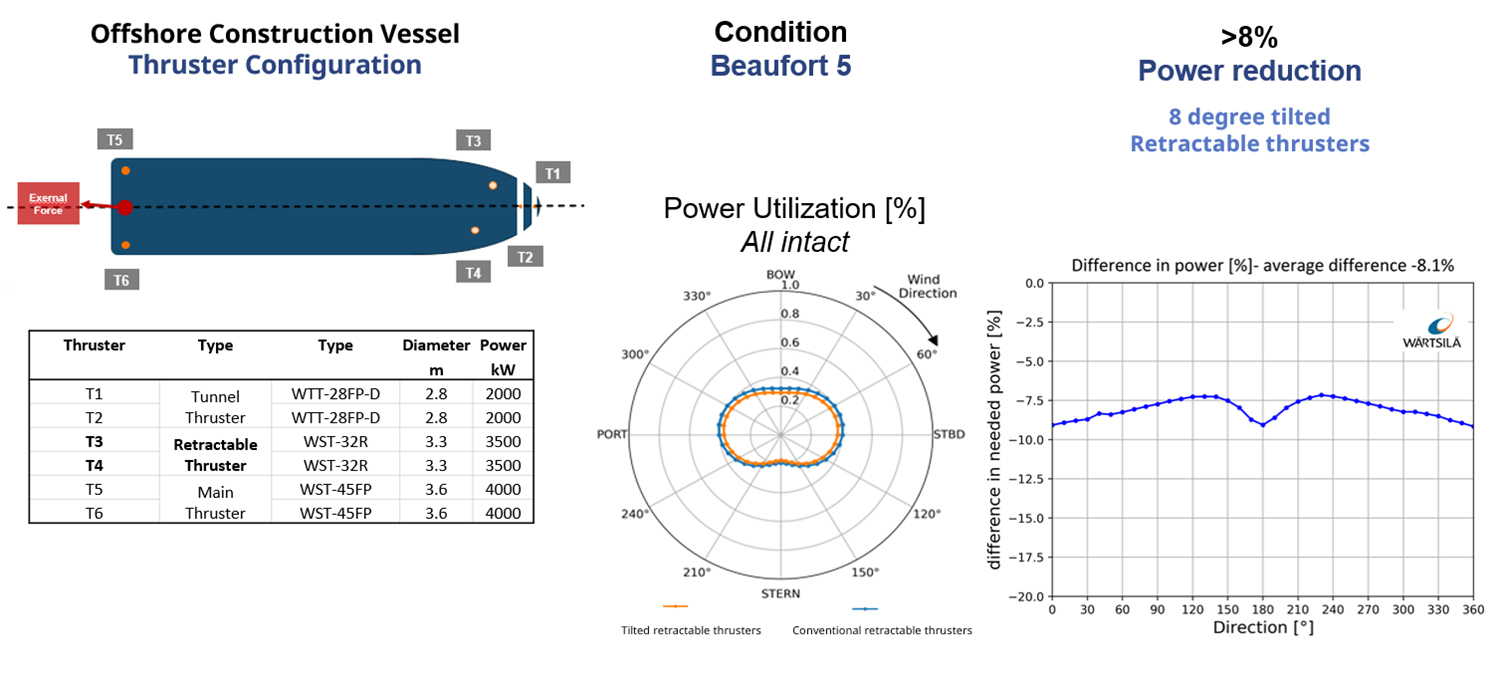

Global decarbonisation targets have led to a boom in the demand for specialised offshore windfarm construction and service vessels. To keep vessels safely in position, retractable thrusters are used for reliable station keeping. But not all retractable thrusters are the same – there are five key features that really matter when station keeping offshore.
With a need for more wind farms to provide more renewable power, the offshore wind market is booming. Wind farms are getting bigger, taller and are being built further offshore in deeper waters. This means the specialised vessels needed to build and service them are getting bigger and operating in more challenging environmental conditions.
Specialised vessels such as those used for turbine installation, foundation installation, cable laying and rock dumping are all in great demand. At the same time, the utilisation rate of offshore oil and gas vessels is increasing, after a dip in 2018. When it comes to thrusters and dynamic positioning (DP) capabilities all these vessels have similar needs: high performance, excellent reliability and impeccable safety.
If you’re looking for a retractable thruster that combines superior performance and efficiency, there are five features you should be demanding:
- Effective thrust with minimal losses
- Optimisation and a holistic approach
- Reliability and easy maintenance
- High efficiency across the board
- Safety and redundancy built in
1. Effective thrust with minimal losses
DP is an essential capability for offshore vessels, so retractable thruster performance is extremely important. The thrusters must be able to keep the vessel in a steady position whatever the conditions.
Most retractable thrusters have a high degree of interaction losses with the hull, which can be as much as 15–20% depending on the hull shape and thruster location. If you can reduce or eliminate these losses, you gain a significant amount of thrust.
For example, in 2018 Wärtsilä introduced a revolutionary 8-degree downwards tilt on the propeller shaft of its retractable thrusters. This tilt minimises the thruster-hull interaction, increasing available thrust by 15–20% compared to non-tilted thrusters, meaning less installed power is needed for the same DP capability. This makes the unit more efficient, reducing emissions and fuel consumption. It also increases DP capability and gives a wider working envelope.
For vessels that can operate up to half their time in DP mode, there are big savings to be made.
The computational fluid dynamics images below clearly show the difference the tilt can make. The top image in Figure 1 shows the water flow in sideway condition of a conventional retractable thruster, while the bottom image shows the flow of a retractable thruster with an 8-degree downwards tilt.
The conventional retractable thruster shows significant interaction with the hull, reducing the effective thrust. The retractable thruster with an 8-degree downwards tilt shows minimal interaction losses, resulting in a higher effective thrust at the same power and leading to a potential fuel saving of up to 10%.

Figure 1. Sideway condition demonstrating the minimal thruster-hull interaction losses with an 8-degree tilted retractable thruster.
Figure 2 compares the two technologies in ahead condition, again showing how the 8-degree tilt minimises thruster–hull interaction losses, resulting in a higher bollard pull. For cable and pipe laying vessels in particular, tilted retractable thrusters can improve bollard pull performance by 15% or more.

Figure 2. Ahead condition demonstrating the minimal thruster¬–hull interaction losses with an 8-degree tilted retractable thruster.
2. Optimisation and a holistic approach
Offshore vessel thruster systems can be incredibly complex. You want transit to be efficient but you also need high DP capability and the ability to enter shallow waters. To do this you need different types of thruster – main thrusters, retractable thrusters and tunnel thrusters – to meet different operational requirements.
There are so many different variables a holistic approach is essential, with the size, weight and number of thrusters optimised and tailored to the unique needs of your vessel early in the design phase.
Although your number-one target might be DP performance, your thruster system should also be able to contribute to better transit performance. And what if a thruster fails? A well-designed system will have redundancy built in. It will also be designed to save weight – a big factor in your fuel consumption calculations.
Luckily there are some fantastic tools to help you with this task backed up by extensive experience and hydrodynamic knowledge. Two examples are Wärtsilä’s OPTI Design and OPTI-DP™ tools, which take into account losses from thruster hull interactions to analyse actual vessel performance in both transit and DP modes. Thruster and hull interaction efficiency is examined in minute detail over 360 degrees, using full-scale thrust performance. Analysing thruster-hull interaction in this way allows you to optimise your whole thruster system to minimise weight while maximising performance.
In the design phase Wärtsilä can even make sure your main and retractable thrusters are the same size to ensure a high level of exchangeability with components – a real benefit when it comes to spare parts and maintenance procedures.
Handpicked related content: Optimising propulsion the smart way: 13 amazing pictures
3. Reliability and easy maintenance
When your vessel is working far out at sea in high waves and harsh conditions you need your thrusters to be reliable. If you do need to carry out repairs, retractable thrusters with easily accessible components can be fixed even when the vessel is afloat.
You should look for a combined steering and retraction seal package with seal protection and redundancy built in. This package should be replaceable onboard while the vessel is afloat. An electric steering and retraction system will mean no pumps or oil – and fewer moving parts means higher reliability plus less space and weight.
Wärtsilä’s retractable thrusters meet all these requirements and have been constantly improved based on extensive experience with more than 300 retractable thrusters delivered over 50 years.
Handpicked related content: Condition monitoring can help you extend your drydock intervals with class approvals using real operational data – saving money and avoiding expensive downtime.
4. High efficiency across the board
To ensure your thruster is fuel-efficient it needs to be as light as possible to leave more room for payload. For example, with the right design choices and the help of tools like Wärtsilä’s in-house OPTI-DP™ design tool, you can save 30–40 tonnes per retractable thruster.
Your thruster should also include electrified auxiliaries to reduce power consumption. As retractable thrusters typically run at quite a low load when in DP operation, Wärtsilä has electrified all the auxiliaries to make them more energy efficient. For example, the electric steering system uses 50% less power than an equivalent hydraulic system.
The design process needs to be able to identify the many small design choices like this that add up to big increases in overall thruster efficiency. OPTI-DP can help to identify these small changes that lead to a highly fuel-efficient result.

Figure 3. Using OPTI-DP™, Wärtsilä experts can plot a vessel’s DP performance, demonstrating the potential power savings.
An 8-degree thruster tilt doesn’t just increase fuel efficiency; it also has another efficiency benefit. If your vessel has multiple thrusters there is a forbidden zone – the area where thrusters interact with each other. The smaller this zone, the higher the thruster operational area – thus the higher the vessel DP capability and the higher total efficiency in DP operation. Thrusters with an 8-degree tilt ensure the smallest forbidden zone and the largest operational area.
5. Safety and redundancy built in
With expensive assets and crew working in harsh conditions offshore, safety is non-negotiable. Retractable thrusters are essential for safe DP operations. Because retractable thrusters are below the base line, they won’t come above the surface even in heavy weather. This means you won’t lose the thrust capability that is essential for safe operations.
The outboard part of the thruster is based on proven technology, which ensures safe and reliable operation without the need for intermediate docking. Retraction is self-locking and supported by a safety nut and sensors to measure wear.
Building redundancy into your system means you can reliably predict your DP capability, which is essential for vessel safety. This is where Wärtsilä’s OPTI-DP™ really comes into its own, as it can accurately estimate thruster efficiency around the whole 360 degrees, far above the industry standard.
As with OPTI-Design, OPTI-DP™ considers the vessel as a whole, with a holistic view of how the different parts of the vessel interact in order to optimise thrust while reducing weight and increasing efficiency.
Safe, effective thrust
When you are in the market for retractable thrusters, here is your non-negotiable list of demands:
- effective thrust with minimal losses
- optimisation and a holistic approach
- reliability and easy maintenance
- high efficiency across the board
- safety and redundancy built in
To tick all these off your list you must consider thrusters at an early stage in your ship’s design process. If you do it later you can still buy high-quality, reliable thrusters but you won’t have the optimum solution.
“When you’re working offshore, you must have high-performance station keeping and DP capabilities. Wärtsilä has the industry’s widest range of retractable thrusters, from 800 kw to 6.5 MW, plus the technology and the hydrodynamic expertise to help design and deliver optimal thruster solutions for offshore vessels.
We’re not just selling a product – we’re selling safe and efficient station keeping performance.”
Vincent Bast, Product Sales Manager, Wärtsilä
Want to go deeper?
Learn how smarter thruster setups and other proven strategies can improve offshore vessel safety, efficiency and compliance. Download this white paper: “Offshore gains – How to tackle three challenges and sharpen your edge”.
Interested in retractable thrusters that include all of the five must-have features described above? Learn more about Wärtsilä retractable thrusters.
Related solutions
Did you like this? Subscribe to Insights updates!
Once every six weeks, you will get the top picks – the latest and the greatest pieces – from this Insights channel by email.



